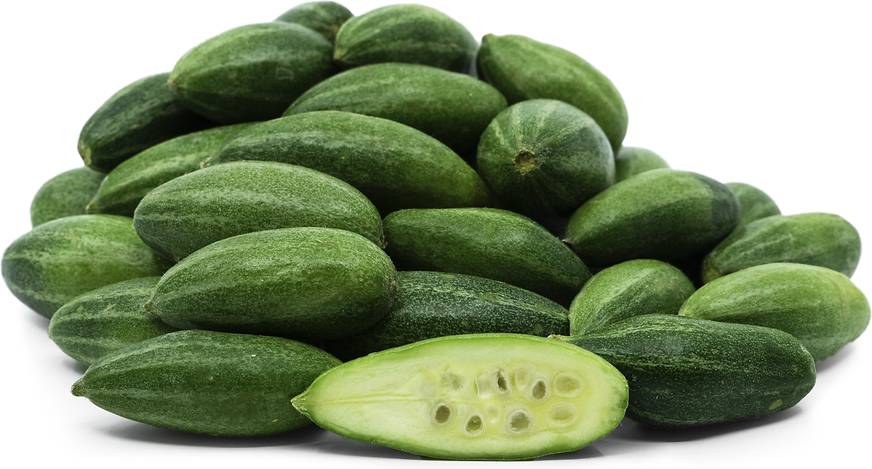


Parwal
Estimated Inventory, lb : 0
Description/Taste
Parwal is small to medium in size, averaging 5-15 centimeters in length, and is globose to oblong in shape with pointed ends. The smooth rind is yellow-green when young, transforming to a burnt orange when mature and can be solid or have some light striping running lengthwise. The flesh is a creamy white, moist, and firm with a central cavity filled with slippery, small ivory seeds. Parwal is mild and bland, allowing it to absorb accompanying flavors, and has a soft texture when cooked.
Seasons/Availability
Parwal is available from mid-summer through mid-fall.
Current Facts
Parwal, botanically classified as Trichosanthes dioica, is a vining plant that can reach over six meters in height and is a member of the Cucurbitaceae family. Mostly known as the Pointed Gourd in English, Parwal is the Hindi name for the gourd and is also known by many other names including Parval in Nepali, Hindi, and Gujarati, Potol or Patol in Bengali, Kambupudalai in Tamil, and colloquially as the Green potato. Parwal is highly regarded in India for its nutritional value and digestibility and is considered a luxury item that can be expensive in the marketplace.
Nutritional Value
Parwal contains vitamins A and C, magnesium, copper, fiber, vitamin B2, calcium, iron, sulfur, and potassium.
Applications
Parwal is best suited for cooked applications such as stir-frying, sautéing, frying, and boiling. To prepare for cooking, the gourd should be peeled, the pointed tips removed and then sliced in half with the tough seeds discarded. The gourd is most often used in curries, tossed into stir-fries with other seasonal vegetables, blended in gravies, or cooked into subzis, which consists of potatoes, yogurt, and vegetables. Parwal can be made into potoler and stuffed with fish, meat, or roe, mixed into stews, cut into cubes and sautéed, fried into strips, or made into soups. The gourd can also be pickled in vinegar with an assortment of herbs and spices. Parwal pairs well with potatoes, tomatoes, onions, ginger, garlic, turmeric, red chili powder, cumin, coriander, garam masala, cilantro, mustard seeds, fennel seeds, peanuts, pistachios, meats such as poultry, beef, pork, and fish, and coconut milk. They will keep up to one week when stored in the refrigerator.
Ethnic/Cultural Info
In Ayurveda, the Indian system of medicine, Parwal is highly favored and is used to balance one's Kapha, which is the stabilizing energies in the body. Parwal is believed to help reduce symptoms of digestive issues, headaches, skin conditions, and fevers. An extract made of the gourd’s seeds is also used to help lower cholesterol and blood sugar levels. Both the leaves and gourds are used in traditional medicine and are typically made into a juice.
Geography/History
Parwal is native to India and has been cultivated in eastern India for over two thousand years, especially in northeastern Indian states such as Bengal, Assam, and Orissa. Today it is also grown in the southern plains of Nepal, tropical Asia, and Australia, and can be found at fresh local markets and specialty grocers.
Recipe Ideas
Recipes that include Parwal. One
| Spice up the Curry |
|
Parwal Ki Sabzi |
| Cooking Carnival |
|
Stuffed Parwal |
| Bliss of cooking |
|
Paneer Stuffed Parwal |




